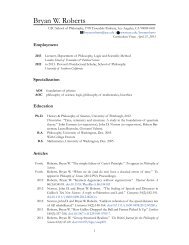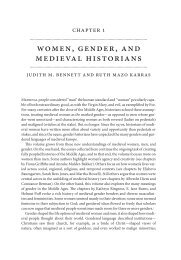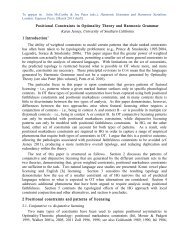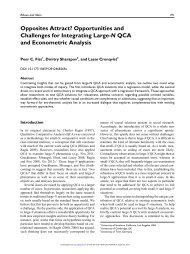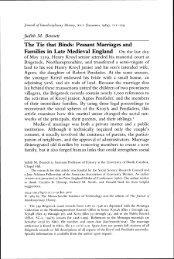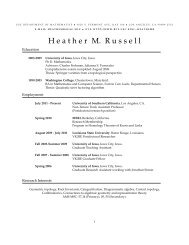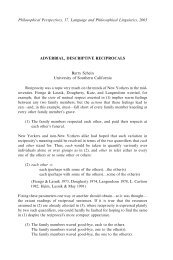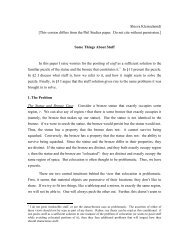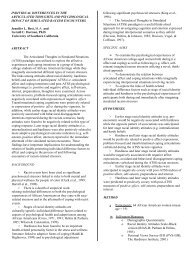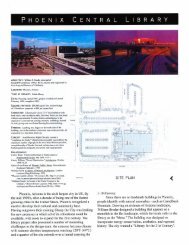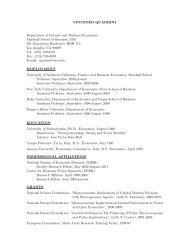The Racial Resegregation of Los Angeles County, 1940-2000
The Racial Resegregation of Los Angeles County, 1940-2000
The Racial Resegregation of Los Angeles County, 1940-2000
You also want an ePaper? Increase the reach of your titles
YUMPU automatically turns print PDFs into web optimized ePapers that Google loves.
2.0 Overview <strong>of</strong> Methods<br />
Questions <strong>of</strong> method loom large in studies <strong>of</strong> U.S. Census data. <strong>The</strong> two crucial areas <strong>of</strong><br />
methodological concern in this study are: 1) “Why are the data from <strong>1940</strong>-<strong>2000</strong><br />
comparable and uniform?”; 2) “How did we define the four principal racial groups?” and<br />
3) “What do the different measures <strong>of</strong> segregation mean?”<br />
2.1 <strong>The</strong> <strong>1940</strong>-<strong>2000</strong> Dataset<br />
This study is based on a uniform dataset, in which comparable data has been organized<br />
into the <strong>2000</strong> Census tract boundaries, from <strong>1940</strong> through <strong>2000</strong> (N=2,055 census tracts).<br />
We began with the <strong>Los</strong> <strong>Angeles</strong> <strong>County</strong> Union Census Tract Data Series, <strong>1940</strong>-1990<br />
(Ethington Kooista and DeYoung <strong>2000</strong>), which is fitted to the 1990 census tract<br />
boundaries. Upon release <strong>of</strong> the California census data in March <strong>of</strong> 2001, we constructed<br />
variables for the four principal race-ethnic groups (see below) that were most compatible<br />
with the way those racial variables were defined in 1990. <strong>The</strong> entire <strong>1940</strong>-1990 data<br />
series were then fitted to the <strong>2000</strong> census tract boundaries using ESRI’s ArcInfo ®<br />
s<strong>of</strong>tware to reallocate 1990 tract aggregates in areal proportion to the polygonal overlays<br />
<strong>of</strong> the <strong>2000</strong> boundaries.<br />
2.2 Definition <strong>of</strong> <strong>Racial</strong> Groups<br />
By convention and by virtue <strong>of</strong> their numerical prominence, social scientists and public<br />
policy makers have come to focus on four principal racial-ethnic groups: White, African-<br />
American or Black, Hispanic or Latino, and Asian and Pacific Islanders. For technical<br />
and also political reasons, Hispanics have been treated by the U.S. Census Bureau as an<br />
“ethnic” rather than a “racial” category. Respondents have been asked wither they hare<br />
“Hispanic” separately from what racial group they belong to. Hispanics, in other words,<br />
can be <strong>of</strong> any race. We have termed this classification method “Hispanic categorical<br />
dominance.” (Meyers and James 2001). By convention and also political necessity,<br />
researchers have essentially “racialized” the supposedly “ethnic” Hispanic category, by<br />
treating “Hispanics” as a comparable category to those <strong>of</strong> “Non-Hispanic Whites,” and<br />
“Non-Hispanic Blacks” In everyday life and ordinary speech, “Hispanic” or “Latino” is<br />
used in the same sense as “White” or “Black” or “Asian.” Thus, we have dispensed with<br />
the cumbersome pretense <strong>of</strong> the race versus ethnic distinction and refer hereafter only to<br />
“racial groups.” Moreover, the <strong>2000</strong> Census famously allowed each respondent to<br />
identify as a member <strong>of</strong> more than one race. <strong>The</strong>re are many ways <strong>of</strong> classifying the<br />
races now, thanks to the millions who have chosen more than one race. In this study, the<br />
most important consideration was to classify races to be most compatible with the 1990<br />
and earlier classification methods. <strong>The</strong> method used here is the “Hispanic categorical<br />
dominance” with “fractional apportionment <strong>of</strong> multiracials.” All persons reporting<br />
Hispanic identity are reserved for the Hispanic category. <strong>The</strong>n, persons reporting more<br />
than one race are fractionally apportioned to the races they report. A person reporting<br />
herself to be “African American or Black” and “White” is apportioned ½ to Black and ½<br />
to White. If she had reported “Hispanic” in addition to these “racial” categories, then<br />
100% <strong>of</strong> her would have gone to the Hispanic category. “Asians” include, <strong>of</strong> course, a<br />
Race Contours <strong>2000</strong> –<strong>Resegregation</strong> <strong>of</strong> <strong>Los</strong> <strong>Angeles</strong> <strong>County</strong>, <strong>1940</strong>-<strong>2000</strong> 4



